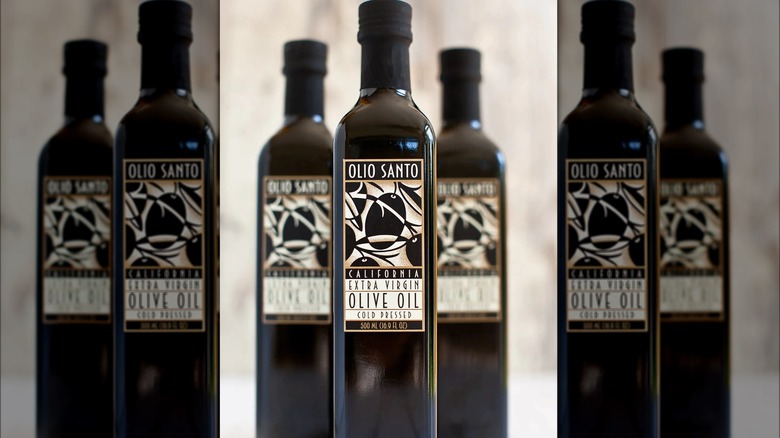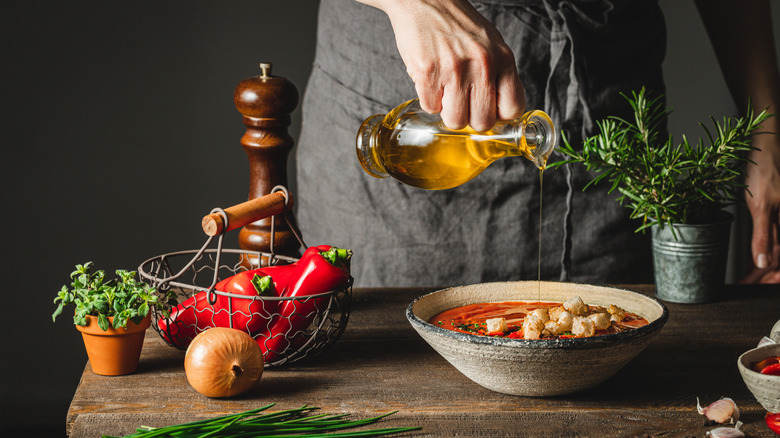Ina Garten's Olive Oil Tip To Make Dishes Less Bitter
Shopping for olive oil has become increasingly confusing as more options have flooded the market. It can be challenging to decode the difference in categories: extra virgin, virgin, pure, light, and cold-pressed olive oil, especially considering the different price points. Some small bottles of peppery finishing oils are more expensive than the two-liter vats sold at Costco, leaving consumers to wonder what they should buy.
After decades in the kitchen, Ina Garten knows what she likes. Her recipes often include preferred brand names or stress the importance of quality, listing 'good olive oil' as an ingredient. Olive oil has a range of flavors, with fruity, bitter, or pungent profiles, impacting the dish. If you want your recipe to taste like Garten's, it helps to use the same quality ingredients she does. When asked about her olive oil preference on the Ask Ina section of her website, Garten said, "I use Olio Santo Olive Oil from California because it's flavorful, fruity, and not heavy."
This cold-pressed extra virgin olive oil is produced in small batches in Napa Valley. Its harvest date is placed on each bottle to ensure freshness. Garten uses the medium-bodied oil for her cooking and raw to dress salads and dip bread where you can appreciate its flavor and lack of bitterness. A 16.9 fluid ounce bottle of Olio Santo EVOO retails for roughly $20 to $27, placing it in the midrange price category for a finishing oil but towards the higher end for an everyday cooking option.
California versus Italian olive oil
The global olive oil industry is projected to reach $18.42 billion by 2030, led by the top exporters, Spain and Italy (per Fortune Business Insights). While it's difficult to generalize a nation's olive oil, comparisons exist between California and Italian varieties.
California is a relative newcomer, having an established production only dating back to about the 1800s. Popular brands like California Olive Ranch and Ina Garten's favorite, Olio Santo, have only produced EVOO for a few decades. Olive oil has a shelf life of between 18 and 24 months, so generally, domestic brands are the freshest, cutting out travel time and tariffs. American olive oil, including Californian, tends to be floral and fruity with hints of apple, grass, nuts, and tomato. In general, California oil tends to be less bitter, making dishes taste more delicate.
Italy has been producing olive oil for thousands of years, making 366,000 metric tons annually. Most Italian olive oil comes from its south and is described as intense and herbal. However, you can find an array of flavors, aromas, and price points. Be mindful of blends since companies can purchase oil from other EU countries and market it as a 'Product of Italy.' The high-demand market is plagued with fraudulent, low-quality oils masked as Italian EVOO, so do your homework. Try single-varietal oils to savor each region's diverse taste, or Italian chef Giada De Laurentiis' favorite olive oil brand, Lucini, which California Olive Ranch now distributes.
Tips for cooking with olive oil
The key to choosing the right olive oil is understanding its attributes and how it can enhance your food. When used raw to finish salads or dishes, you can appreciate its nuances, so buy the best oil for your budget. If the oil comes into contact with moderate to high heat, use a more affordable option since its subtleties won't be noticeable. Extra virgin olive oil has a smoking point of 410 degrees Fahrenheit, making it safe for all cooking.
The USDA grades olive oil based on bitterness, fruitiness, and pungency. Extra virgin is the highest grade. These pricier oils are aromatic and fruity with a yellow-to-deep green color. Virgin is the next best, followed by olive and refined olive oil. As you step down in grade, the oil becomes more processed, cheaper, and less nuanced, with a more neutral flavor and lighter color. Virgin and fresher olive oils tend to have a more pronounced bitterness that you can detect on the sides of your tongue. However, if the taste is too intense, consider using a blend with a lower concentration of the bitter compounds or buying a California type.
Purchase olive oil in dark glass or opaque bottle since light degrades it. Keep it away from heat sources, including window sills, lights, or the stove. If the oil tastes, looks, or smells bad, including musty or vinegary notes, or it has sediment, it may be rancid and should be discarded.



